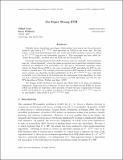| dc.contributor.author | Vyas, Nikhil | |
| dc.contributor.author | Williams, Ryan | |
| dc.date.accessioned | 2021-02-17T19:57:55Z | |
| dc.date.available | 2021-02-17T19:57:55Z | |
| dc.date.issued | 2021-01 | |
| dc.identifier.issn | 1076-9757 | |
| dc.identifier.uri | https://hdl.handle.net/1721.1/129796 | |
| dc.description.abstract | Multiple known algorithmic paradigms (backtracking, local search and the polynomial method) only yield a 2[superscript n(1-1/O(k))] time algorithm for k-SAT in the worst case. For this reason, it has been hypothesized that the worst-case k-SAT problem cannot be solved in 2[superscript n(1-f(k)/k)] time for any unbounded function f. This hypothesis has been called the "Super-Strong ETH", modelled after the ETH and the Strong ETH. | en_US |
| dc.description.sponsorship | NSF (Grants CCF-1741615 and CCF-1909429) | en_US |
| dc.publisher | AI Access Foundation | en_US |
| dc.relation.isversionof | https://doi.org/10.1613/jair.1.11859 | en_US |
| dc.rights | Article is made available in accordance with the publisher's policy and may be subject to US copyright law. Please refer to the publisher's site for terms of use. | en_US |
| dc.source | Journal of Arti cial Intelligence Research (JAIR) | en_US |
| dc.title | On Super Strong ETH | en_US |
| dc.type | Article | en_US |
| dc.identifier.citation | Vyas, Nikhil and Ryan Williams. "On Super Strong ETH." Journal of Artificial Intelligence Research 70 (January 2021): 473-495 © 2021 AI Access Foundation | en_US |
| dc.contributor.department | Massachusetts Institute of Technology. Computer Science and Artificial Intelligence Laboratory | en_US |
| dc.relation.journal | Journal of Artificial Intelligence Research | en_US |
| dc.eprint.version | Final published version | en_US |
| dc.type.uri | http://purl.org/eprint/type/JournalArticle | en_US |
| eprint.status | http://purl.org/eprint/status/PeerReviewed | en_US |
| dspace.date.submission | 2021-02-11T16:24:14Z | |
| mit.journal.volume | 70 | en_US |
| mit.license | PUBLISHER_POLICY | |
| mit.metadata.status | Complete | |
